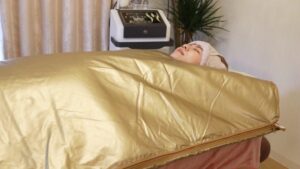Introduction:
When it comes to relaxation and wellness, both Japanese ganbanyoku and traditional saunas offer unique experiences. But, what exactly sets them apart? In this blog post, we will delve into the differences between these two popular heat therapies, their benefits, and how you can choose the perfect one for your needs.
What is Japanese Ganbanyoku?
Ganbanyoku, also known as “rock bathing” or “stone sauna,” is a Japanese heat therapy where you lie on heated volcanic rocks. The stones emit far-infrared rays and negative ions, which are believed to provide a range of health benefits. The temperature in a ganbanyoku room typically ranges between 104°F (40°C) and 122°F (50°C).
Benefits of Ganbanyoku:
- Improved blood circulation
- Detoxification through sweating
- Relief from muscle and joint pain
- Stress reduction
- Boosted metabolism and calorie burning
Hyper Radon Mat

You can also enjoy the benefits of ganbanyoku at an esthetic salon by using a “Hyper Radon Mat” a specially designed mat that replicates the experience and therapeutic effects of lying on heated volcanic rocks, making it a convenient and accessible option for those who want to try this unique therapy.
What is a Traditional Sauna?
A traditional sauna is a small room with wooden interiors, heated to high temperatures using a stove or an electric heater. The temperature in a sauna ranges from 160°F (71°C) to 200°F (93°C). It may use dry heat or incorporate steam by pouring water on the heated stones.
Benefits of Sauna:
- Enhanced cardiovascular health
- Relaxation and stress relief
- Improved immune system
- Relief from muscle soreness and joint pain
- Skin rejuvenation
The Key Differences
Temperature: Ganbanyoku rooms have lower temperatures compared to traditional saunas. This makes them more comfortable and accessible for those who may not tolerate high heat well.
Humidity: While traditional saunas can be dry or steamy, ganbanyoku rooms have a moderate humidity level that is comfortable for most people.
Atmosphere: Ganbanyoku offers a more calming and meditative experience as you lie on the heated rocks, while traditional saunas usually have seating arrangements.
Which One is Right for You?
Your choice between ganbanyoku and a traditional sauna will depend on your personal preferences, heat tolerance, and health goals. If you’re seeking a gentler, more meditative experience with moderate temperatures, ganbanyoku might be your best choice. However, if you prefer higher heat levels and the option of steam, a traditional sauna could be more suitable.
Conclusion:
Japanese ganbanyoku and traditional saunas each offer unique experiences and health benefits. By understanding their differences, you can make an informed decision about which heat therapy is best for your needs. Whichever you choose, both options can help you relax, rejuvenate, and improve your overall well-being.